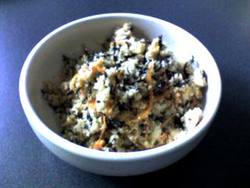- Okara (food)
-
This article is about a food. For the city of the same name, see Okara, Pakistan."Unohana" redirects here. For the Bleach (manga) character, see Retsu Unohana.
Okara 
Unohana, a typical Japanese dish made from okaraJapanese name Hiragana おから Rōmaji okara Korean name Hangul 비지 or 콩비지 Revised Romanization biji or kongbiji Chinese name Chinese 雪花菜 or 豆腐渣 Hanyu Pinyin xuě huā cài or doùfǔ zhā Okara or Soy Pulp is a white or yellowish pulp consisting of insoluble parts of the soybean which remain in the filter sack when pureed soybeans are filtered in the production of soy milk. It is part of the traditional cuisines of Japan, Korea, and China, and since the 20th century has also been used in the vegetarian cuisines of Western nations.
Okara is low in fat, high in fiber, and also contains protein, calcium, iron, and riboflavin. It contains 76 to 80% moisture, 20 to 24% solids and 3.5 to 4.0% protein. On a dry weight basis okara contains 24% protein, 8 to 15% fats,and 12 to 14.5% crude fiber. It contains 17% of the protein from the original soybeans.
Uses
While relatively flavourless when eaten on its own, it can be used in stews such as the Korean biji-jjigae (비지찌개),photo or in porridges, or as a taste neutral addition to bread and pastry doughs. In Japan it is used in a side dish called unohana (卯の花),photo which consists of okara cooked with soy sauce, mirin, sliced carrots, burdock root and shiitake mushrooms. Occasionally unohana is used as a substitute for the rice in sushi.[1] Okara can also be fermented with the fungus Rhizopus oligosporus to make okara tempeh (called tempe gembus in Indonesian).
Okara is also eaten in the Shandong cuisine of eastern China by steaming a wet mixture of okara that has been formed into blocks of zha doufu (渣豆腐; literally "tofu from (soy) sediment/residue"), also known as xiao doufu or cai doufu,(小豆腐/菜豆腐; literally "little tofu" or "vegetable tofu")[1]. Often the dish is made directly from ground soybeans without first turning it into okara. The texture of this dish vaguely resembles polenta.
However, as a significant byproduct of soy milk and tofu manufacturing, okara is commonly used as animal feed since its production usually exceeds demands for human consumption. For this reason, it is not uncommon for tofu and soymilk factories to be located close to animal farms in many Asian countries. In Western countries, okara is used almost exclusively for the production of pig and cattle feed, although it does appear as an ingredient for vegetarian burger patties.
Okara is also the raw material used to make soy yarn.
Taken raw, the soy pulp is inedible, but can be used as a powerful natural detergent in manual dishwashing.
References
- ^ "Sushi History: Chronology, origin and genealogy". Sushi Encyclopedism. http://homepage3.nifty.com/maryy/eng/sushi_history.htm. Retrieved 2008-02-22.
- Shurtleff, William, and Akiko Aoyagi (1979). Tofu & Soymilk Production. Volume 2: The Book of Tofu.
External links
- Ellen's Kitchen: okara tempeh
- Mother Earth News article on tempeh, including okara tempeh
- Okara Mountain: recipe blog
- Okara Project: recipe blog
Shandong cuisine Cuisine of Hong Kong · Cuisine of Macao · Chinese cuisine · History of Chinese cuisine Soy General Soy allergy · Soy candle · Soy ink · Soy molasses · Soy paint · Soy protein · Soybean · Soybean diseases · Soybean meal · Soybean oil

Soy based dishes Aburaage · Agedashi tofu · Bai ye · Douhua · Dubu kimchi · Edamame · Hiyayakko · Kongguksu · Kongnamul · Mapo doufu · Miso soup · Sundubu jjigae · Tahu goreng · Tofu skin roll · Yong Tau Foo
Milk substitute Meat analogues Sauces and condiments Dajiang · Doenjang · Doubanjiang · Douchi · Kinema · Miso · Nattō · Soy sauce · Teriyaki · Tauco · Tian mian jiang · Tương · Yellow soybean paste
Various other foods Mamenori · Okara · Oncom · Soy flour · Soy milk based infant formula · Stinky tofu · Tofu skin
Companies 8th Continent · Alpro · Boca Burger · Gardenburger · Morningstar Farms · Silk · So Good · Tofutti · Turtle Mountain · Vitasoy · Yeo Hiap Seng
Categories:- Soy products
- Shandong cuisine
- Japanese cuisine
- Japanese cuisine terms
- Korean cuisine
- Vegan cuisine
- Vegetarian cuisine
- Tofu
Wikimedia Foundation. 2010.

